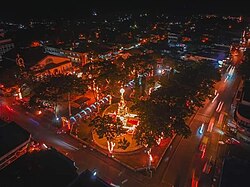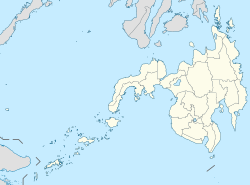
Malaybalay, officially the City of Malaybalay, is a 1st class component city and capital of the province of Bukidnon, Philippines. According to the 2020 census, it has a population of 190,712 people.

Valencia, officially the City of Valencia, is a 2nd class component city in the province of Bukidnon, Philippines. According to the 2020 census, it has a population of 216,546 people.

Poblacion is the common term used for the administrative center, central, downtown, old town or central business district area of a Philippine city or municipality, which may take up the area of a single barangay or multiple barangays. It is sometimes shortened to Pob.
The Philippines is divided into four levels of administrative divisions with the lower three being defined in the Local Government Code of 1991 as local government units (LGUs). They are, from the highest to the lowest:
- Regions, mostly used to organize national services. Of the 17 regions, only one – the Bangsamoro Autonomous Region in Muslim Mindanao – has an elected government to which the central government has devolved competencies.
- Provinces, independent cities, and one independent municipality (Pateros).
- Component cities and municipalities within a province.
- Barangays within a city or municipality.

A purok is a division within a barangay in the Philippines. While not officially considered a local government unit (LGU), a purok often serves as a unit for delivering services and administration within a barangay.
In the Philippines, local government is divided into three levels: provinces and independent cities, component cities and municipalities, and barangays, all of which are collectively known as local government units (LGUs). In one area, above provinces and independent cities, is an autonomous region, the Bangsamoro Autonomous Region in Muslim Mindanao. Below barangays in some cities and municipalities are sitios and puroks. All of these, with the exception of sitios and puroks, elect their own executives and legislatures. Sitios and puroks are often but not necessarily led by an elected barangay councilor.
Casisang is the most populous of the 46 barangays of Malaybalay. It is the seat of government of the City of Malaybalay since the City Hall is located here. Situated in the South Highway District of Malaybalay, Casisang borders on the north with the Poblacion barangays of Barangay 11, Barangay 7, and Barangay 9, on the east with Can-ayan, on the south with San Jose, Magsaysay, and Mapayag, and on the West by Imbayao and Kalasungay. According to 2015 census Casisang has a population of 25,696 people.
Dalwangan is a barangay west of Malaybalay City situated on the foothills of the Kitanglad Range, 12 kilometers west of the city proper. It is bounded to the north by Impalutao of the municipality of Impasugong, to the east by Patpat and Kalasungay, to the south by Capitan Angel and the Mount Kitanglad Range Natural Park, and to the west by Kibenton of Impasugong. According to the 2015 census, Dalwangan has a population of 7,004 people.
Bangcud is an urban barangay in the South Highway District of Malaybalay City, Bukidnon, in the Philippines.
Aglayan is an urban barangay of the City of Malaybalay in the Province of Bukidnon, Philippines. According to the 2015 census, Aglayan has a population of 7,594 people.

Can-ayan is a rural barangay in the North Highway District of Malaybalay City, Bukidnon, Philippines. According to the 2015 census, Can-ayan has a population of 5,870 people.
San Jose is an urban barangay in the South Highway District of Malaybalay, Bukidnon. According to the 2015 census, it has a population of 6,856. It is located 6 kilometres south of the city proper and bounded to the north by Casisang, to the east by Can-ayan, to the south by Laguitas and Linabo, and to the west by Magsaysay. San Jose is divided by the Sawaga River into a billowy plain to the west and a hilly and rugged east. It is politically subdivided into fifteen purok. Sitios under its jurisdiction include Santo Niño, Mabuhay, and Panamucan. Santo Niño is located to the west, bordering Barangay Magsaysay. Mabuhay is located along the Sawaga. Panamucan is located to the east on the Paiwaig River. Economy is mainly driven by agriculture, but commerce and industry are growing as a result of the urbanization of Malaybalay. There are many infrastructure, land development and housing projects, including a water reservoir and a diversion road by-passing the city proper and leading into Dalwangan.
Saint Peter is a rural barangay in the Upper Pulangi District of Malaybalay City, Bukidnon. It is situated 63 kilometres northeast of the city proper, on the east bank of the Pulangi River. According to the 2015 census, it has a population of 2,324 people.
Kalasungay is an urban barangay in the North Highway District of Malaybalay, Bukidnon, along the Sawaga River. According to the 2015 census, it has a population of 8,272 people.
Laguitas is a rural barangay in the South Highway District of Malaybalay, Bukidnon, in the Philippines. It is bounded to the north and east by San Jose, to the south by Linabo and Aglayan, and to the west by Magsaysay. According to the 2015 census, it has a population of 3,233 people.
Apo Macote is a rural barangay in the Basakan District of Malaybalay City, in the province of Bukidnon, Philippines. It is the southernmost barangay of Malaybalay. According to the 2015 census, Apo Macote has a population of 4,903 people.
Simayà is a barangay in the Basakan District of the city of Malaybalay, Philippines. As of 2015, it has a population of 4,161. It was formerly a sitio of Linabo and was converted into a regular barangay in 1954.

Sumpong is an urban barangay of the City of Malaybalay in the Province of Bukidnon, Philippines. According to the 2015 census, Sumpong has a population of 9,302 people. It is bounded to the north by Kibalabag, to the east by Can-ayan, to the south by the Poblacion District, and to the west by Kalasungay.
Kibalabag is a rural barangay in the North Highway District of Malaybalay, Philippines. As of 2015, it has a population of 1,158 people.

Malaybalay, the capital of Bukidnon, is subdivided into 46 barangays. The Philippine Standard Geographic Code classifies 15 barangays as urban and 31 rural; however, the City of Malaybalay classifies 18 barangays as urban and 28 rural. These barangays are grouped into five administrative districts, namely Basakan, North Highway, Poblacion, South Highway, and Upper Pulangi.








